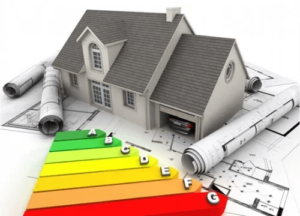Request Your SAP Calculations Quote Online Or Call 0800 917 4026
SAP Calculations are required for the following building types:
- Newly built properties.
- Conversion of a single dwelling into flats or apartments.
- Extension of properties.
- Conservatories – these are highly glazed extensions with a 25% glazing-to-floor ratio.
- Commercial to domestic conversions.
- Barn conversion
The Importance of SAP Calculations for New Builds
 SAP calculations are essential for new constructions to ensure they adhere to Part L of the Building Regulations in England and Wales, Section 6 in Scotland, or Part F1 in Northern Ireland. These calculations assess the energy efficiency of the building, which is crucial for obtaining an Energy Performance Certificate (EPC). An EPC is required by law for the selling or renting of homes, as part of the government’s efforts to lower carbon emissions and address fuel poverty.
SAP calculations are essential for new constructions to ensure they adhere to Part L of the Building Regulations in England and Wales, Section 6 in Scotland, or Part F1 in Northern Ireland. These calculations assess the energy efficiency of the building, which is crucial for obtaining an Energy Performance Certificate (EPC). An EPC is required by law for the selling or renting of homes, as part of the government’s efforts to lower carbon emissions and address fuel poverty.
SAP Calculations Process with Complete EPC
It’s advisable to initiate SAP calculations during the design phase of new constructions. This allows for adjustments to be made early on if the building does not meet the required standards, saving time and expense.
The process at COMPLETE EPC for L1A SAP calculations is divided into two phases: the ‘design stage’ SAP report and the ‘as built’ SAP report. These evaluations include measuring the building’s energy performance aspects such as external fabric area and openings, construction materials, and energy consumption from heating, lighting, and ventilation systems.
The goal is to ensure compliance with Target Emissions Rates (TER), Target Fabric Energy Efficiency (TFEE), Dwelling Emission Rate (DER), and Dwelling Fabric Energy Efficiency (DFEE) standards.
Why You Need ‘U’ Value?
U Value is the reciprocal of all resistances of the materials found in the building element. To calculate the U-Value of the building element, the R-Value of all the different components that make up that element will be considered.
The higher the ‘U’ value the greater the rate of heat loss.
The Necessity of SAP Calculations for Extensions
For extensions, L1B SAP calculations ensure compliance with Part L of the Building Regulations in England and Wales. These calculations, focused on energy efficiency, are crucial for aligning extensions with the government’s carbon reduction and fuel poverty mitigation strategies.
Conducting SAP Calculations for Extensions with Complete EPC
We recommend starting SAP calculations at the design phase to facilitate potential modifications. For extensions, the COMPLETE EPC’s L1B process includes a ‘notional report’ and a ‘proposed report,’ comparing the two to ensure the entire property meets Part L1B standards. The process involves evaluating the energy performance of both the existing structure and the extension through detailed assessments and comparisons using SAP calculation software.
Overglazed Extension (DFLEX)

Why SAP Calculations are Essential for Conversions
When converting a building from commercial to residential use, or altering its existing residential layout, it’s crucial to meet current building regulations focused on energy efficiency. This is where Standard Assessment Procedure (SAP) calculations come into play, serving as a vital tool in ensuring that conversions comply with Part L of the Building Regulations in England and Wales, as well as equivalent standards across Scotland and Northern Ireland.
Promoting Sustainable Development
Initially developed to assess and compare the energy and environmental performance of buildings, SAP calculations are now integral in promoting sustainable development. This is particularly relevant in conversions, where older structures often need significant updates to meet modern energy efficiency standards.
Updating EPC
A key reason for requiring SAP calculations in conversions is to update the Energy Performance Certificate (EPC). While commercial buildings typically have an EPC, converting these buildings for residential use demands a re-evaluation to ensure they meet the stricter criteria applicable to living spaces. An outdated EPC can’t guarantee that a converted building will be energy efficient or environmentally friendly, which is increasingly important in today’s energy-conscious market.
Reducing Electricity Costs
Moreover, the government’s ongoing commitment to reduce carbon emissions and tackle fuel poverty aligns closely with the need for effective SAP calculations. These calculations not only help in planning energy-saving measures but also play a critical role in ensuring that new residents enjoy lower energy bills and a smaller carbon footprint. This is not just good for the occupants but also benefits the broader community by contributing to national environmental targets.
SAP Calculation Process for Conversions with Complete EPC
The process of conducting SAP calculations for a conversion typically involves several detailed steps, starting with a ‘notional report’ based on the existing building’s features. This is followed by a ‘proposed report’ that outlines the intended changes and improvements. The key is to demonstrate through these reports that the converted building will have better energy performance than the original. This involves detailed assessments of insulation, heating systems, lighting, and other factors that influence energy consumption.
For those undertaking building conversions, starting the SAP calculations early in the project is advisable. This proactive approach allows for identifying and rectifying any potential issues that might prevent the building from meeting the required energy efficiency standards. It also provides an opportunity to make design adjustments that can significantly enhance the building’s environmental performance.
Documentation Required for SAP Calculations
For any SAP calculation process, the following documents are necessary:
- Floor plans for both the existing and proposed property.
- Elevation drawings for both the existing and proposed property.
- Section drawing showing each floor’s height.
- Specifications of proposed elements like walls, floors, roofs, and glazing.
- Details of the heating system.
These documents and assessments form the foundation of ensuring that constructions, extensions, and conversions not only meet regulatory requirements but also contribute to energy conservation and environmental protection goals.
🔴As Design Stage - Predicted Energy Assessment
The Predicted Energy Assessment for As Built (SAP) Calculation UK is a vital document in the planning process for any new property.
- We review your plans and requirement and make recommendations accordingly.
- We are your guide to attaining a pass.
- Complete EPC guarantees a pass based on our direction.
- We offer SAP design and compliance advice.
- We provide Design stage SAP calculations.
- Projected energy certificate.
- We can help calculate your U-value.
- We supply all documents well before your time limit.
SAP Compliance Report

🟡As Built Stage - On Construction Energy Performance Certificate
An On Construction EPC records how energy efficient the property is as a building by means of a rating between A and G ratings, A being the highest. On Construction EPCs are produced off plan using full SAP (standard assessment procedure). The certificate must be shown to Building Control.
🟢Marketing Stage - Compliance with Building Regulations
Once the On Construction EPC has passed building control, you can market the property to sell or rent and show potential buyers and tenants the energy rating of the property, In Scotland, you must display the EPC somewhere in the property, for example in the meter cupboard or next to the boiler. An EPC contains: information about a property’s energy use and typical energy costs.
Conclusion
SAP calculations are not just a formality but a fundamental part of transforming buildings for modern use. They ensure that conversions are not only legally compliant but also aligned with environmental goals that benefit everyone.
By integrating SAP calculations into the early stages of a conversion project, developers can pave the way for buildings that are energy efficient, economically beneficial for occupants, and environmentally sound. This strategic approach helps create living spaces that are not only fit for today but also sustainable for generations to come, marking a positive step forward in the construction and renovation industry.
SAP Calculations Quote
Get Your SAP Calculations Quote:
"*" indicates required fields












